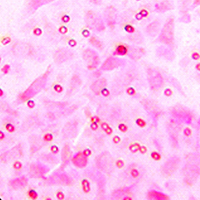Long noncoding RNA H19 accelerates tenogenic differentiation by modulating miR-140-5p/VEGFA signaling

Submitted: 28 June 2021
Accepted: 24 July 2021
Published: 7 September 2021
Accepted: 24 July 2021
Abstract Views: 1228
PDF: 683
Supplementary: 117
HTML: 18
Supplementary: 117
HTML: 18
Publisher's note
All claims expressed in this article are solely those of the authors and do not necessarily represent those of their affiliated organizations, or those of the publisher, the editors and the reviewers. Any product that may be evaluated in this article or claim that may be made by its manufacturer is not guaranteed or endorsed by the publisher.
All claims expressed in this article are solely those of the authors and do not necessarily represent those of their affiliated organizations, or those of the publisher, the editors and the reviewers. Any product that may be evaluated in this article or claim that may be made by its manufacturer is not guaranteed or endorsed by the publisher.
Similar Articles
- H. Huang, W. Wang, P. Liu, Y. Jiang, Y. Zhao, H. Wei, W. Niu, TRPC1 expression and distribution in rat hearts , European Journal of Histochemistry: Vol. 53 No. 4 (2009)
- A Mandich, A Massari, S Bottero, G Marino, Histological and histochemical study of female germ cell development in the dusky grouper Epinephelus marginatus (Lowe, 1834) , European Journal of Histochemistry: Vol. 46 No. 1 (2002)
- R Iwasaki, S Matsubara, T Takizawa, T Takayama, Human amniotic epithelial cells are morphologically homogeneous: enzymehistochemical, tracer, and freeze-substitution fixation study , European Journal of Histochemistry: Vol. 47 No. 3 (2003)
- Leen Uyttebroek, Casper Pype, Guy Hubens, Jean-Pierre Timmermans, Luc van Nassauw, Effect of TNBS-induced colitis on enteric neuronal subpopulations in adult zebrafish , European Journal of Histochemistry: Vol. 64 No. 3 (2020)
- M Fukuda, A Sun, The DNA-instability test as a specific marker of malignancy and its application to detect cancer clones in borderline malignancy , European Journal of Histochemistry: Vol. 49 No. 1 (2005)
- Ennio Pannese, Quantitative, structural and molecular changes in neuroglia of aging mammals: A review , European Journal of Histochemistry: Vol. 65 No. s1 (2021): Special Collection on Advances in Neuromorphology in Health and Disease
- S Bettini, F Ciani, V Franceschini, Cell proliferation and growth-associated protein 43 expression in the olfactory epithelium in Poecilia reticulata after copper solution exposure , European Journal of Histochemistry: Vol. 50 No. 2 (2006)
- Editor in Chief, In memoriam of Alberto Calligaro: Master of Histology and Life , European Journal of Histochemistry: Vol. 66 No. 1 (2022)
- S. Lomoio, D. Necchi, E. Scherini, Uneven distribution of NG2 cells in the rat cerebellar vermis and changes in aging , European Journal of Histochemistry: Vol. 56 No. 3 (2012)
- T Takubo, S Wakui, K Daigo, K Kurokata, T Ohashi, K Katayama, M Hino, Expression of non-muscle type myosin heavy polypeptide 9 (MYH9) in mammalian cells , European Journal of Histochemistry: Vol. 47 No. 4 (2003)
<< < 72 73 74 75 76 77 78 79 80 > >>
You may also start an advanced similarity search for this article.

 https://doi.org/10.4081/ejh.2021.3297
https://doi.org/10.4081/ejh.2021.3297











